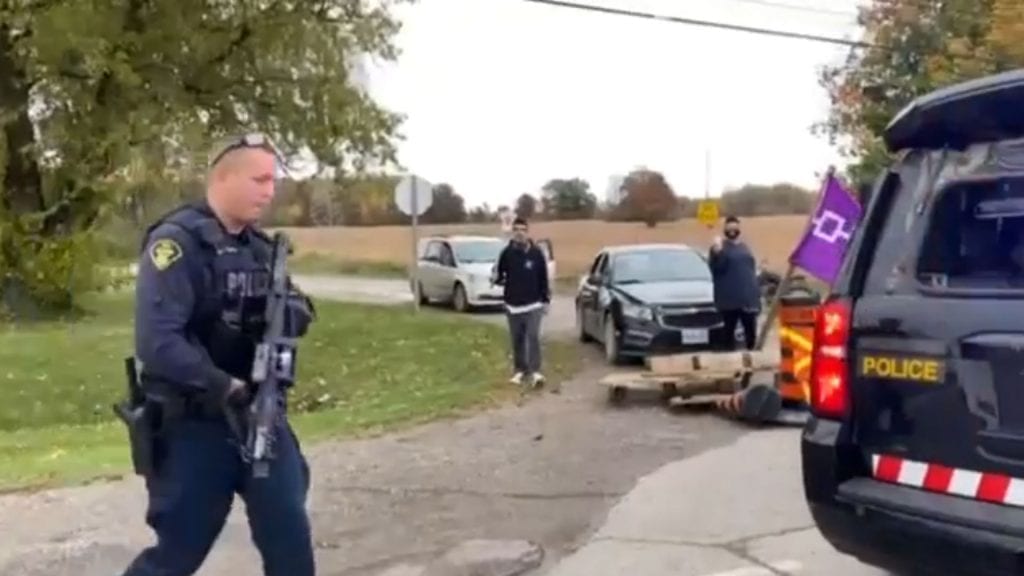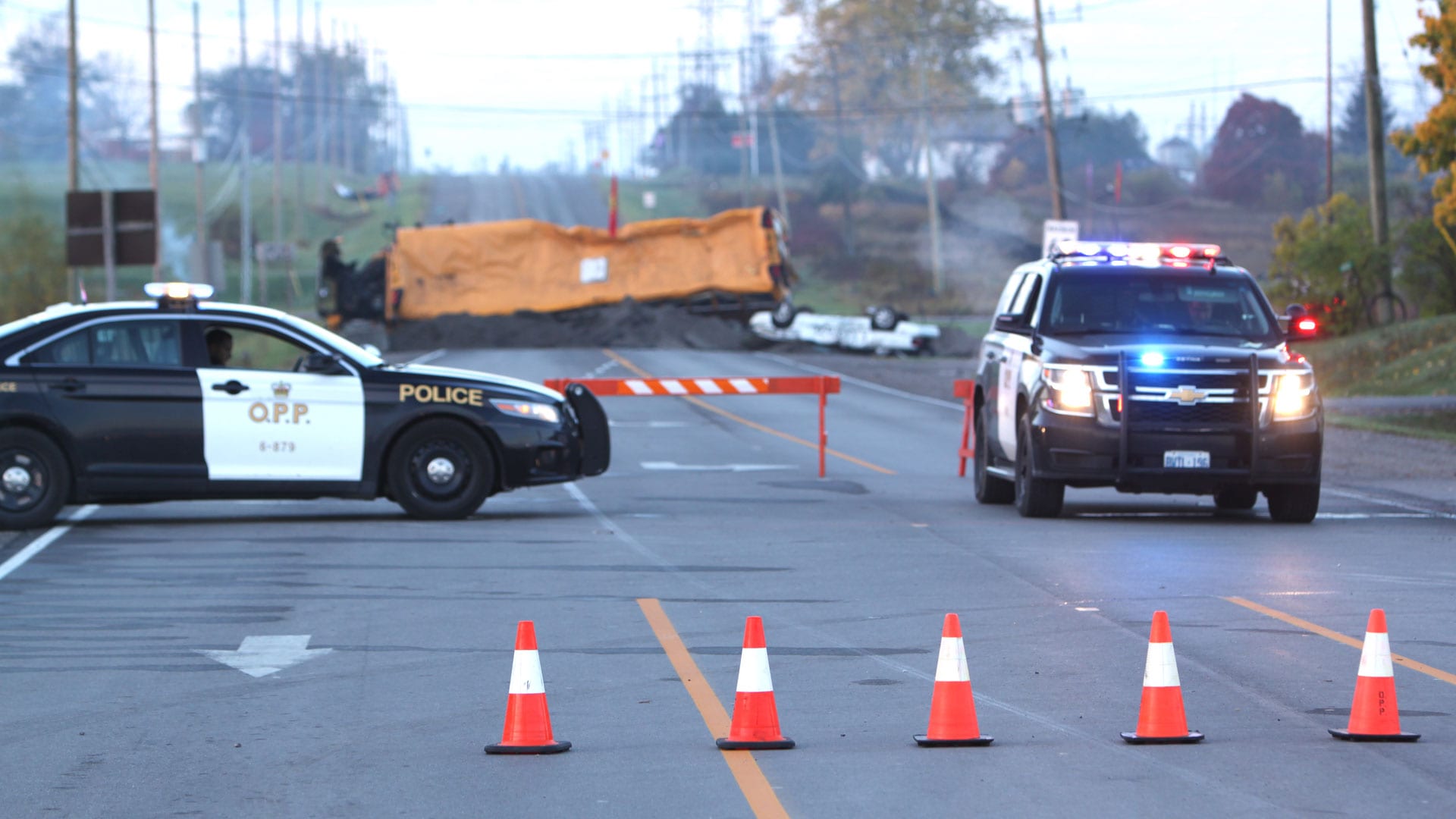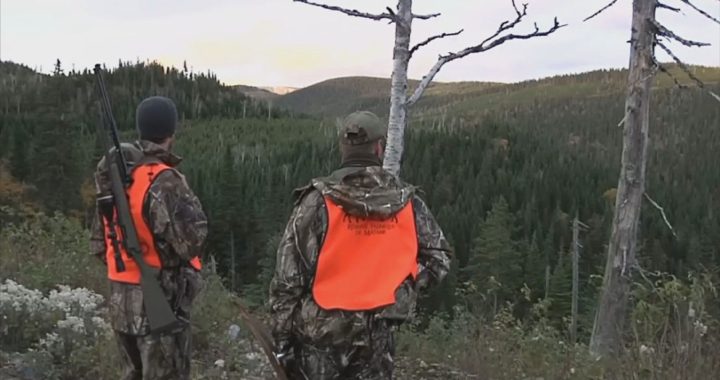
A screenshot from bystander video shows a police officer holding a large riot control gun on Oct 22. Police say they fired one round of rubber bullets during the altercation. Photo: Facebook
People from the Six Nations of the Grand River have shut down critical infrastructure in Caledonia, Ont. after police Tasered one person and fired projectiles from a high velocity riot gun outside the back entrance to the 1492 Land Back Lane camp, which has halted construction of a disputed subdivision 20 km south of Hamilton.
The skirmish happened at the intersection of Argyle Street and Sixth Line where the “safety zone” support camp is located. Video shows part of the clash in which an Ontario Provincial Police (OPP) officer hops out of a cruiser and points the rubber bullet gun at someone.
“Put your f—ing gun away,” people shout as other officers block the road. The officer eventually hops into the cruiser and drives away as people pelt it with rocks and debris.
Watch: Six Nations people confront police
“I pulled some taser darts out of my brother’s back,” land back spokesperson Skyler Williams posted online afterward.
Only hours earlier a judge granted permanent injunctions barring blockades and ordering the occupation ended. Williams self-represented but was found in contempt of the existing injunctions. The virtual court muted him and struck his submissions from the record.
“This is the violence we’ve been talking about with the OPP coming down here,” he continued. “So now, as a result of this, Hwy 6 again has been blocked, the train tracks bordering our community have been blocked, Argyle Street has been blocked.”
Video on social media shows plumes of thick black smoke billowing up from a tire fire as people manned the quickly-erected road barricade. Power was shut down after a hydro pole was set ablaze outside the gates of Kanonhstaton, which was set to become the Douglas Creek Estates when Six Nations people reclaimed it 14 years ago.
They reinforced the position with a crushed-up school bus and a white sedan. The same white sedan was dragged back behind the gates on Aug. 21, almost exactly two months prior and on the same spot.
Six Nations members fortified their positions throughout the night with heavy machinery, digging up a large trench and setting a fire outside the front entrance to the camp at 1535 McKenzie Rd.

That front entrance was open for over a month before the injunctions were last served in September. That’s when the land backers blocked it with a spray-painted Nissan Sentra. The road in front of the Nissan stood totally destroyed on Friday.
The CN Rail tracks and the Hwy 6 bypass around Caledonia are immediately adjacent to the northeast boundary of the established Six Nations reserve. Both were closed after the Aug. 5 raid.
“People all across Turtle Island are starting to stand up and understand that we can’t tolerate this anymore. And we won’t,” Williams continued. “Our people are standing up across the nation.”
Police tweeted Thursday that officers used “appropriate non-lethal force” after cruisers were approached by “McKenzie Meadows protesters.”
#OPP cruisers parked on Argyle Street approached by McKenzie Meadows protestors. Cruisers heavily damaged as protest violence escalated. For their safety, OPP members used appropriate non-lethal force in response. No injuries. Investigation underway. ^rl
— OPP West Region (@OPP_WR) October 22, 2020
Yet police knew this would happen and expected it, according to a court filing from the senior officer in command of the region.
“Critical infrastructure such as railways, bridges and hydro stations may be attacked and damaged in retaliation for the use of force by police,” said Chief Supt. John Cain in affidavit.
“To the extent the use of force is necessary, an operation of this type requires carefully planning so as to reduce the likelihood of violence and managing any backlash.”
The Superior Court judge who heard this testimony called the prospect “quite frightening.”
“As a society, we cannot be held hostage to violence and threats of violence,” Justice John Harper wrote. “Legitimate claims and grievances can and should be played out in a peaceful and respectful process that includes negotiations with various levels of government.”
OPP spokesperson Const. Rod LeClair said police resorted to force after people hit parked cruisers with rocks.
“The goal is to stop the threat to the public or police with the lowest level of risk to the subject(s), public and officer,” he wrote.
“Police are required to respond to the behaviour presented to them in the safest manner possible, and the use of force is always a last resort.”
The mayor of Haldimand County, which Caledonia is part of, remains vocal.
In preceding months Ken Hewitt has called on police to enforce the injunction but soon modified his position and supported the OPP’s decision to change tactics and start arresting or charging people off site rather than raid it.
He recently released an open letter suggesting the municipality is displeased with what it calls the “catch and release” aspect of this approach. Court previously heard that some who had been arrested, charged and released were also charged a second time afterward.

In his latest statement, Hewitt criticizes Williams for not seizing the opportunity to bring a constitutional question before the court, which would have added both Queen’s Park and Ottawa to the proceedings.
“I have and will always support a process that brings the Nations together to adopt a transparent methodology that will advance the Haldimand Tract claims,” said Hewitt. “It must be done peacefully and respectfully. None of which would be consistent of the actions of those on Mackenzie Meadows.”
Hewitt, the judge and the Six Nations band council explain that the disputed McKenzie Road site cannot be legally returned to the community because it’s been possessed by third-parties since 1853, though the community may have a claim against Canada for breach of fiduciary duty.
The elected council signed an agreement in to publicly support the development in 2019, but the traditional Haudenosaunee Confederacy chiefs were not consulted. The Confederacy publicly supported the land back occupation on Aug. 15.
The occupied construction site sits within former Oneida Township, which the nations argue was never surrendered but reserved for their future use. A 1990 specific claim alleges that the Crown is guilty of selling reserve lands and not fairly remunerating the Six Nations.
This specific claim was closed in 1995 when the elected council sued Ontario and Canada for an accounting of cash, lands or other assets owed as a result of misuse of funds and land misdealing along the Grand River.
It is in active litigation with a trial slated for 2022.










